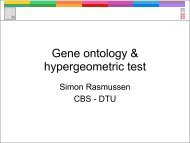Computational tools and Interoperability in Comparative ... - CBS
Computational tools and Interoperability in Comparative ... - CBS
Computational tools and Interoperability in Comparative ... - CBS
Create successful ePaper yourself
Turn your PDF publications into a flip-book with our unique Google optimized e-Paper software.
although <strong>in</strong> trees where both Pseudomonas <strong>and</strong> Ac<strong>in</strong>etobacter<br />
are present, A. borkumensis tends to cluster more<br />
often with the latter one.<br />
The major structural feature of the A. borkumensis<br />
chromosome is its symmetry <strong>and</strong> homogeneity. The<br />
genome conta<strong>in</strong>s only very few regions with extraord<strong>in</strong>arily<br />
low or high curvature, position preference or base<br />
stack<strong>in</strong>g energy. The chromosomal frame is symmetric:<br />
The orig<strong>in</strong> <strong>and</strong> the term<strong>in</strong>us of replication are located<br />
opposite to each other <strong>in</strong> the chromosome <strong>and</strong> are clearly<br />
discerned by maxima of oligonucleotide usage biases<br />
between lead<strong>in</strong>g <strong>and</strong> lagg<strong>in</strong>g str<strong>and</strong>.<br />
The genetic repertoire of A. borkumensis is most similar<br />
to that of Ac<strong>in</strong>etobacter <strong>and</strong> P. aerug<strong>in</strong>osa. Moreover,<br />
<strong>Comparative</strong> genomics of Alcanivorax borkumensis 9<br />
Fig. 8. Codon usage (A <strong>and</strong> B) <strong>and</strong> am<strong>in</strong>o acid usage (C <strong>and</strong> D) of A. borkumensis SK2 compared with those of 518 completely sequenced<br />
bacteria (A <strong>and</strong> C) or compared with those of 16 sequenced oceanic bacteria. Frequencies of am<strong>in</strong>o acids <strong>and</strong> codons were counted for each<br />
genome <strong>and</strong> normalized. Mean value (grey l<strong>in</strong>e) <strong>and</strong> three st<strong>and</strong>ard deviations (grey solid area) represent the global usage of <strong>in</strong>dividual<br />
codons (A <strong>and</strong> B) <strong>and</strong> am<strong>in</strong>o acids (C <strong>and</strong> D) <strong>in</strong> the 518 (A <strong>and</strong> C) or 16 (B <strong>and</strong> D) reference genomes. The red l<strong>in</strong>e (A <strong>and</strong> B) shows the<br />
codon usage <strong>and</strong> the blue l<strong>in</strong>e (C <strong>and</strong> D) shows the am<strong>in</strong>o acid usage of A. borkumensis.<br />
A. borkumensis shares a similar oligonucleotide usage<br />
with the Xanthomonadales <strong>and</strong> Pseudomonadales <strong>in</strong>dicat<strong>in</strong>g<br />
close phylogenetic relationships with these orders<br />
<strong>in</strong> accordance with 16S rDNA sequence relatedness<br />
(Schneiker et al., 2006). Amongst this subgroup of completely<br />
sequenced genomes, the A. borkumensis chromosome<br />
harbours the relatively lowest number of genome<br />
isl<strong>and</strong>s with atypical tetranucleotide usage. P. putida<br />
KT2440, for example, carries threefold more isl<strong>and</strong>s per<br />
Megabase <strong>in</strong> its chromosome (We<strong>in</strong>el et al., 2002). Interest<strong>in</strong>gly,<br />
one of the three enzyme systems that are<br />
upregulated <strong>in</strong> alkane-grown cells (Sabirova et al., 2006),<br />
the well-known alkB1 cluster, is encoded by genome<br />
isl<strong>and</strong>s. The molecular evolution of the alk genes that are<br />
©2007TheAuthors<br />
Journal compilation © 2007 Society for Applied Microbiology <strong>and</strong> Blackwell Publish<strong>in</strong>g Ltd, Environmental Microbiology









